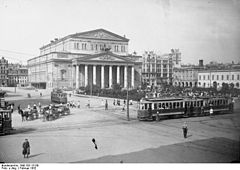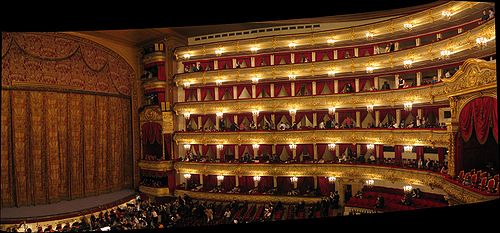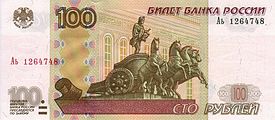- Bolshoi Theatre
-
This article is about the ballet and opera house in Russia. For the drama theatre in Saint Petersburg, see Bolshoi Drama Theatre. For the rock music band Bolshoi, see The Bolshoi.
Coordinates: 55°45′37″N 37°37′07″E / 55.76028°N 37.61861°E
Bolshoi Theatre Большой театр
Bolshoi Theatre in 2011General information Type Opera and ballet theatre Architectural style Neoclassical Location Moscow, Russia Coordinates 55°45'37"N, 37°37'07"E Completed 1825 The Bolshoi Theatre (Russian: Большой театр, Bol'shoy Teatr, meaning Large, Great or Grand Theatre, also spelled Bolshoy) is a historic theatre in Moscow, Russia, designed by architect Joseph Bové, which holds performances of ballet and opera. The Bolshoi Ballet and Bolshoi Opera are amongst the oldest and most renowned ballet and opera companies in the world. The theatre is the parent company of The Bolshoi Ballet Academy, a world-leading school of ballet.
The main building of the theatre, rebuilt and renovated several times during its history, is a landmark of Moscow and Russia (its iconic neoclassical facade is depicted on the Russian 100-ruble banknote). On 28 October 2011, the Bolshoi was re-opened after an extensive six year renovation costing about 21 billion rubles (about $680 million).[1] The renovation included restoring acoustics to the original quality (which had been lost during the Soviet Era), as well as restoring the original Imperial decor of the Bolshoi.[1]
Contents
History
The company was founded in 1776 by Prince Peter Urusov and Michael Maddox. Initially, it held performances in a private home, but in 1780, it acquired the Petrovka Theatre and began producing plays and operas.
The current building was built on Theatre Square in 1824 to replace the Petrovka Theatre, which had been destroyed by fire in 1805. It was designed by architect Andrei Mikhailov, who had built the nearby Maly Theatre in 1824.
At that time, all Russian theatres were imperial property. Moscow and St Petersburg each had only two theatres, one intended for opera and ballet (these were known as the Bolshoi Theatres), and one for plays (tragedies and comedies). As opera and ballet were considered nobler than drama, the opera houses were named "Grand Theatres" ("Bolshoi" is Russian for "large" or "grand") and the drama theatres were called the "Smaller Theatre" ("Maly" is Russian for "small", "lesser", or "little").
The Bolshoi Theatre's original name was the Imperial Bolshoi Theatre of Moscow, while the St. Petersburg Bolshoi Theatre (demolished in 1886), was called the Imperial Bolshoi Kamenny Theatre.
The Moscow theatre was inaugurated on 18 January 1825 with a performance of Fernando Sor's ballet, Cendrillon. Initially, it presented only Russian works, but foreign composers entered the repertoire around 1840. A fire in 1853 caused extensive damage; reconstruction was carried out by Alberto Cavos, son of Catterino Cavos, an opera composer. The theater reopened in 1856. During World War II, the theatre was damaged by a bomb, but it was immediately repaired.
The Bolshoi has been the site of many historic premieres including Tchaikovsky's The Voyevoda and Mazeppa, and Rachmaninoff's Aleko and Francesca da Rimini. Feodor Chaliapin, Leonid Sobinov, Antonina Nezhdanova, Ksenia Derzhinskaia and other outstanding opera singers have performed at the Bolshoi.
Important dates
- 17 March 1776 — creation of the Bolshoi company, thus laying the foundation of the Bolshoi Theatre
- 30 December 1780 — opening of the Petrovsky theatre
- 8 October 1805 — fire and destruction of the building of the Petrovsky theatre
- 1806 — Theatre granted the status of "Imperial Theatre"
- 13 April 1808 — opening of New Arbat Imperial Theatre
- 1812 — fire and destruction of the theatre as a consequence of the French invasion of Moscow
- 1821—1824 — building of a new theatre, designed by Joseph Bové
- 6 January 1825 — opening of the Bolshoi (Big) Petrovsky Theatre
- 1843 — large-scale reconstruction of the theatre from the design by A. Nikitin
- 11 March 1853 — fire and destruction of the building of the theatre
- 14 May 1855 — approval of the reconstruction project for the theatre building. The project is undertaken by А. Kavos.
- 20 August 1856 — opening of the Bolshoi Theatre
- 16 December 1888 — première of the opera Boris Godunov by Modest Mussorgsky
- 1895 — capital repairs of the building of the theatre
- 10 October 1901 — première of the opera The Maid of Pskov (Nikolai Rimsky-Korsakov) with Feodor Chaliapin acting as Ivan the Terrible
- 4 May 1919 — creation of the first symphony concert of the orchestra of the theatre conducted by Sergei Koussevitzky
- 7 December 1919 — renamed: the State Academic Bolshoi theatre
- 12 December 1919 — attempt to abolish the Bolshoi theatre
- 18 February 1921 — opening of Beethoven Hall
- 1921—1923 - reconstruction of the theatre under auspices of Ivan Rerberg
- 1935 — première of Dmitri Shostakovich' opera Lady Macbeth of the Mtsensk District
New stage
The New Stage of the Bolshoi Theatre was opened on November 29, 2000. A new stage was built to the left of the historic Main Stage of the Bolshoi. Together with auxiliary buildings (a restored 17th century building, two rehearsal halls, and artists' recreation rooms) it became a single theater complex, the Bolshoi Theatre of Russia. The new building is built on a natural hill, where until recently there were blocks of old houses with communal apartments.[2]
21st-century renovation
From July 2005 to October 2011 the Theatre was closed for restoration. It had undergone many renovations in its time, but none as major as this. The building, whose architecture includes three different styles, was damaged, and a quick renovation seemed to be necessary. The renovation was initially due to cost 15 billion rubles ($610 million), but engineers found that the structure was more than 75% unstable[3] and it was then estimated that about 25.5 billion rubles (app. $850 million) would need to be spent. However, at the completion of the restoration, it was announced that only 21 billion rubles were spent.[4] The work was funded entirely by the federal government.[5]
Despite the reconstruction, the company was operational, with performances held on the New Stage and on the stage of the Great Kremlin Palace. On 28 October 2011, the Bolshoi Theatre was re-opened with a concert featuring international artists and the ballet and opera companies.[6]
The renovation included an improvement in the acoustics to restore it to the level of the pre-Soviet era[7] as well as the restoration of the original Imperial decor.[1] The restoration also repaired the foundation and brickwork.
Inside the theatre, the entire space was stripped from the bottom up; the 19th-century wooden fixtures, silver stage curtain, and French-made red velvet banquettes were removed for repair in specialist workshops. Outside, on the top of the facade, the double-headed eagle of the original Russian coat of arms was installed in the place where the Soviet hammer and sickle had been mounted for decades.
Ballet and opera
The Bolshoi is a repertory theatre, meaning that it draws from a stable of productions, any one of which may be performed on a given evening. It normally introduces two to four new ballet or opera productions each season and retires a similar number. The sets and costumes for most productions are made in the Bolshoi's own workshops. The performers are drawn primarily from the Bolshoi's regular ballet and opera companies, with occasional guest performances. Since the collapse of the Soviet Union, there have been a few attempts to reduce the theatre's traditional dependence on large state subsidies. Corporate sponsorship occurs for some productions, but state subsidy is still the lifeblood of the company.
The Bolshoi has been associated from its beginnings with ballet. Tchaikovsky's ballet Swan Lake premiered at the theatre on 4 March 1877. Other staples of the Bolshoi repertoire include Tchaikovsky's The Sleeping Beauty and The Nutcracker, Adam's Giselle, Prokofiev's Romeo and Juliet, and Khachaturian's Spartacus.
After the death of Joseph Stalin, international touring companies went out from the Bolshoi and became an important source of cultural prestige, as well as foreign currency earnings. As a result, the "Bolshoi Ballet" became a well-known name in the West. However, the Bolshoi suffered from losses through a series of defections of its dancers. The first occurrence[8] was on 23 August 1979, with Alexander Godunov; followed by Leonid Kozlov and Valentina Kozlova on 16 September 1979;[9][10] and other cases in the following years. Bolshoi-related troupes continue to tour regularly in the post-Soviet era.
The opera company specializes in the classics of Russian opera such as Mussorgsky's Boris Godunov, Glinka's A Life for the Tsar, and Rimsky-Korsakov's The Tsar's Bride, as well as the operas of Tchaikovsky. Many operas by western composers are also performed, especially works of Italian composers such as Rossini, Verdi, and Puccini. Until the mid-1990s, most foreign operas were sung in Russian, but Italian and other languages have been heard more frequently on the Bolshoi stage in recent years.
Some operas, such as Borodin's Prince Igor, include extensive ballet sequences. Many productions, especially of classic Russian opera, are given on a scale of grand spectacle, with dozens of costumed singers and dancers on stage for crowd or festival scenes.
Current cultural status
The Bolshoi Theatre is famous throughout the world. It is frequented by many tourists, with the result that prices can be much higher than other Russian theatres. This is especially the case for ballet, where the prices are comparable to those for performances in the West. For local citizens concerts and operas are still relatively affordable, with prices ranging from 350 rubles (balcony seats for matinee performances) to 5,000 rubles (for the seats in the orchestra or stalls).
Notes
- The Bolshoi Kamenny Theatre used to exist in Saint Petersburg. It stood next to the Circus Theatre (rebuilt in 1860 as the Mariinsky Theatre), but it was replaced in the 1890s by the present-day building of the St. Petersburg Conservatory. It was at St. Petersburg's Bolshoi that the first great Russian operas, Glinka's A Life for the Tsar and Ruslan and Lyudmila, premiered.
- The Bolshoi Ballet has a branch at the Bolshoi Theatre School in Joinville, Brazil.
- In a bit of ideological editing, the Bolshoi theater appears to be "destroyed" by the device of a split screen in Dziga Vertov's Man with a Movie Camera.
Music directors
- Vassily Sinaisky (from 2010)[11]
- Leonid Desyatnikov (2009–2010)
- Alexander Vedernikov (2001–2009)[12]
- Gennady Rozhdestvensky (2000–2001)
- Mark Ermler (1998–2000)
- Peter Feranec (1995–1998)
- Alexander Lazarev (1987–1995)
- Yuri Simonov (1970–1985)
- Gennady Rozhdestvensky (1965–1970)
- Yevgeny Svetlanov (1963–1965)
- Alexander Melik-Pashayev (1953–1963)
- Nikolai Golovanov (1948 –1953)
- Ariy Pazovsky (1943–1948)
- Samuil Samosud (1936–1942)
See also
- Valery Levental
- Fuat Mansurov
References
- ^ a b c "Bolshoi Theatre to reopen after major refit", BBC News on bbc.co.uk, 28 October 2011
- ^ The New Stage of Bolshoi Theatre, See You in Moscow
- ^ Saving Bolshoi Theater New York Times, 4 February 2008
- ^ "Bolshoi Theater raises curtain after six-year restoration". RIA Novosti. 28 Oct 2011. http://en.rian.ru/art_living/20111028/168218484.html. Retrieved 29 Oct 2011.
- ^ "Bolshoi to reopen late in 2009 after rescue work" "Entertainment", on reuters.com
- ^ "Bolshoi Theatre to reopen after major refit", BBC News on bbc.co.uk, 28 October 2011
- ^ "The State Academic Bolshoi Theatre of Russia: Reconstruction & Renovation: Theatre Reconstruction" on bolshoi.ru/en
- ^ Turmoil on the Tarmac TIME Magazine, September 3, 1979
- ^ "Today in History - September 18". WorldofQuotes. http://www.worldofquotes.com/history/9_18/7/index.html. Retrieved 2011-10-30.
- ^ "Brouhaha at the Bolshoi" TIME Magazine, October 1, 1979
- ^ Amie Ferris-Rotman (2010-09-21). "New musical director opens Bolshoi's 235th season". Reuters. http://www.reuters.com/article/2010/09/21/us-russia-bolshoi-director-idUSTRE68K3FB20100921. Retrieved 2011-06-01.
- ^ Conductor exits left as Bolshoi Theatre's woes mount[dead link]
External links
- Bolshoi Theatre website (English)
- Bolshoi Theatre in Theatrical Russia Annual Dictionary
- For Ballet Lovers Only: Bolshoi dancers of the past and of today in biographies and photos
- Chief Conductors
- Bolshoi Theatre School in Brazil website
- Bolshoi Delights Cuba Audience Photo Feature, Havana Times, Feb 15, 2010
- Reconstruction of Bolshoi Theatre, Pictures
- The New Stage of Bolshoi Theatre, Pictures
Categories:- Visitor attractions in Moscow
- Culture in Moscow
- Opera houses in Russia
- Theatres in Moscow
- Buildings and structures completed in 1825
- Soviet culture
- Russian ballet
Wikimedia Foundation. 2010.












